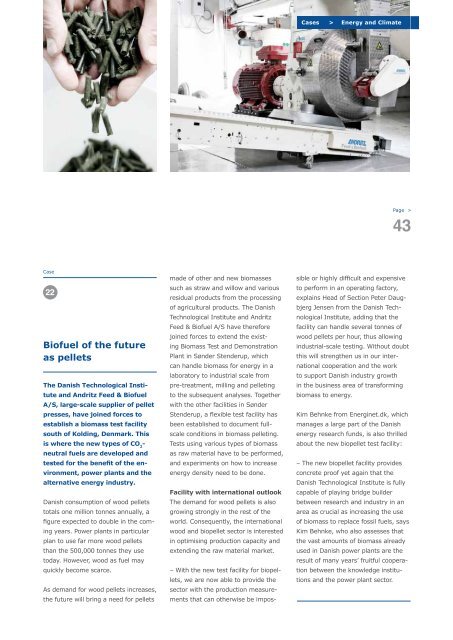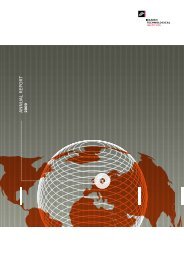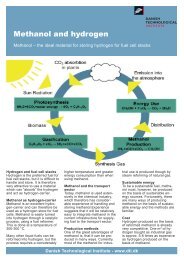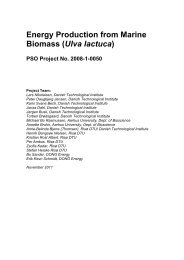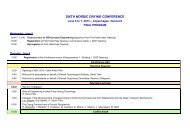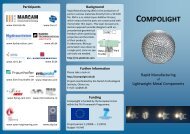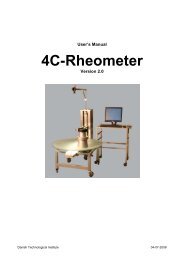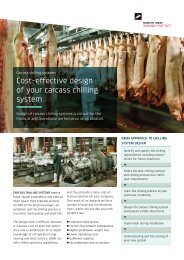Annual Report 2010 (4.1 MB) - Danish Technological Institute
Annual Report 2010 (4.1 MB) - Danish Technological Institute
Annual Report 2010 (4.1 MB) - Danish Technological Institute
You also want an ePaper? Increase the reach of your titles
YUMPU automatically turns print PDFs into web optimized ePapers that Google loves.
Cases > Energy and Climate<br />
Page ><br />
43<br />
Case<br />
22<br />
Biofuel of the future<br />
as pellets<br />
The <strong>Danish</strong> <strong>Technological</strong> <strong>Institute</strong><br />
and Andritz Feed & Biofuel<br />
A/S, large-scale supplier of pellet<br />
presses, have joined forces to<br />
establish a biomass test facility<br />
south of Kolding, Denmark. This<br />
is where the new types of CO 2<br />
-<br />
neutral fuels are developed and<br />
tested for the benefit of the environment,<br />
power plants and the<br />
alternative energy industry.<br />
<strong>Danish</strong> consumption of wood pellets<br />
totals one million tonnes annually, a<br />
figure expected to double in the coming<br />
years. Power plants in particular<br />
plan to use far more wood pellets<br />
than the 500,000 tonnes they use<br />
today. However, wood as fuel may<br />
quickly become scarce.<br />
As demand for wood pellets increases,<br />
the future will bring a need for pellets<br />
made of other and new biomasses<br />
such as straw and willow and various<br />
residual products from the processing<br />
of agricultural products. The <strong>Danish</strong><br />
<strong>Technological</strong> <strong>Institute</strong> and Andritz<br />
Feed & Biofuel A/S have therefore<br />
joined forces to extend the existing<br />
Biomass Test and Demonstration<br />
Plant in Sønder Stenderup, which<br />
can handle biomass for energy in a<br />
laboratory to industrial scale from<br />
pre-treatment, milling and pelleting<br />
to the subsequent analyses. Together<br />
with the other facilities in Sønder<br />
Stenderup, a flexible test facility has<br />
been established to document fullscale<br />
conditions in biomass pelleting.<br />
Tests using various types of biomass<br />
as raw material have to be performed,<br />
and experiments on how to increase<br />
energy density need to be done.<br />
Facility with international outlook<br />
The demand for wood pellets is also<br />
growing strongly in the rest of the<br />
world. Consequently, the international<br />
wood and biopellet sector is interested<br />
in optimising production capacity and<br />
extending the raw material market.<br />
– With the new test facility for biopellets,<br />
we are now able to provide the<br />
sector with the production measurements<br />
that can otherwise be impossible<br />
or highly difficult and expensive<br />
to perform in an operating factory,<br />
explains Head of Section Peter Daugbjerg<br />
Jensen from the <strong>Danish</strong> <strong>Technological</strong><br />
<strong>Institute</strong>, adding that the<br />
facility can handle several tonnes of<br />
wood pellets per hour, thus allowing<br />
industrial-scale testing. Without doubt<br />
this will strengthen us in our international<br />
cooperation and the work<br />
to support <strong>Danish</strong> industry growth<br />
in the business area of transforming<br />
biomass to energy.<br />
Kim Behnke from Energinet.dk, which<br />
manages a large part of the <strong>Danish</strong><br />
energy research funds, is also thrilled<br />
about the new biopellet test facility:<br />
– The new biopellet facility provides<br />
concrete proof yet again that the<br />
<strong>Danish</strong> <strong>Technological</strong> <strong>Institute</strong> is fully<br />
capable of playing bridge builder<br />
between research and industry in an<br />
area as crucial as increasing the use<br />
of biomass to replace fossil fuels, says<br />
Kim Behnke, who also assesses that<br />
the vast amounts of biomass already<br />
used in <strong>Danish</strong> power plants are the<br />
result of many years’ fruitful cooperation<br />
between the knowledge institutions<br />
and the power plant sector.


